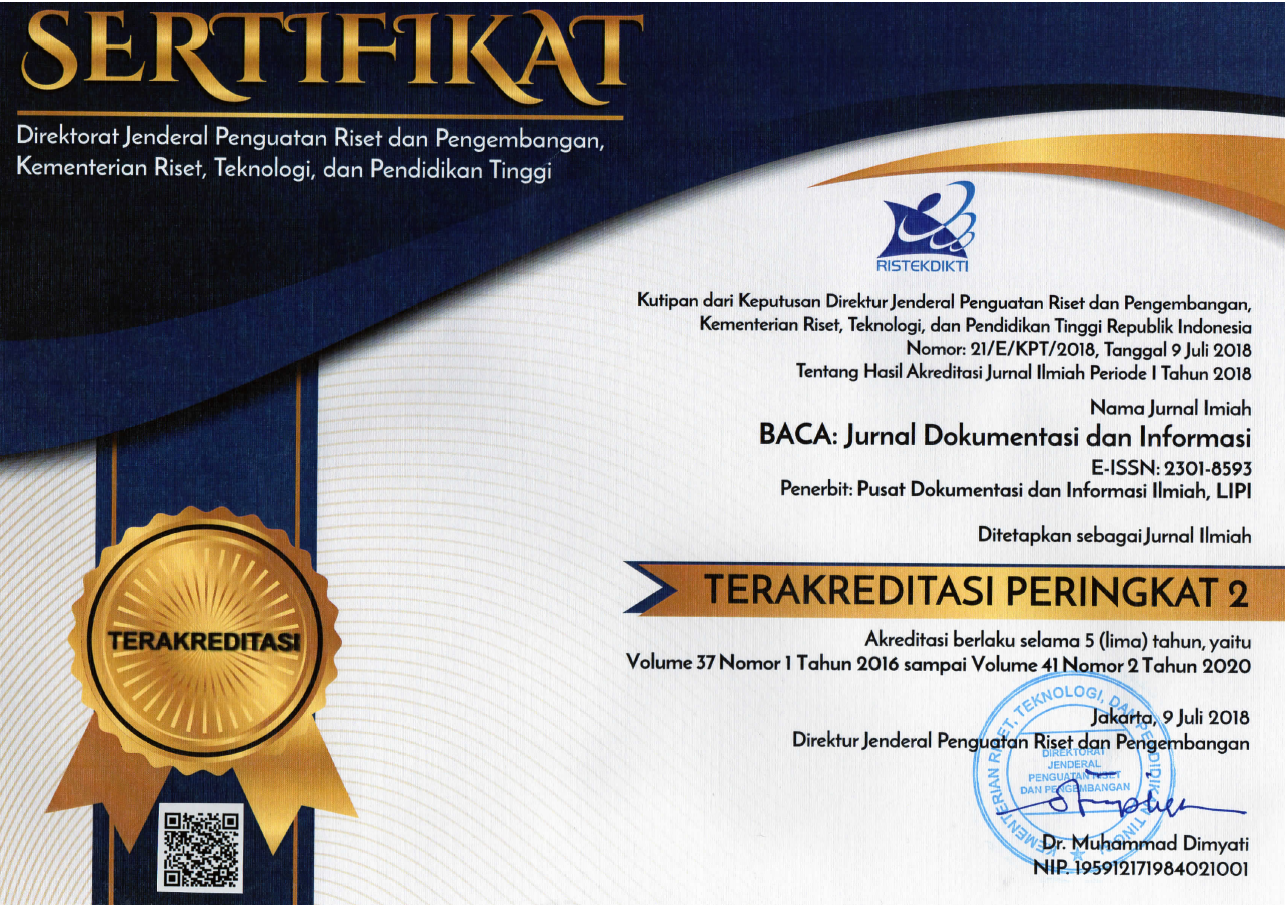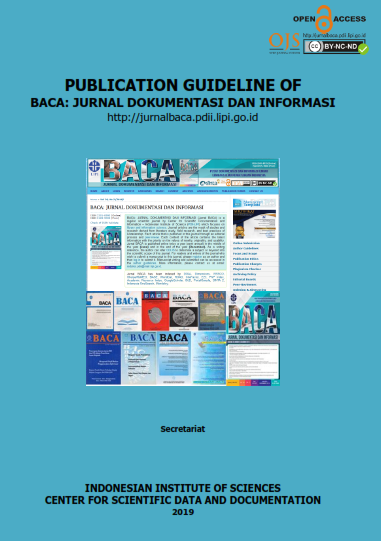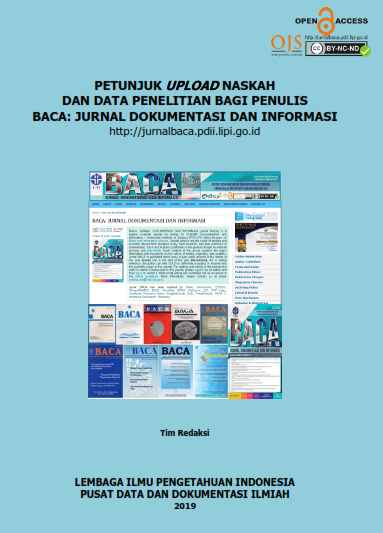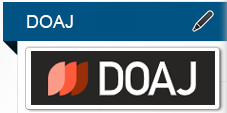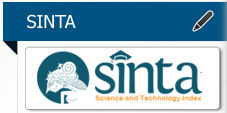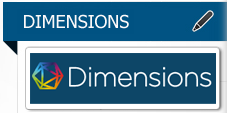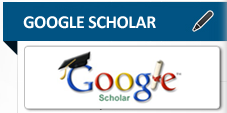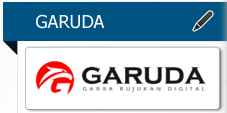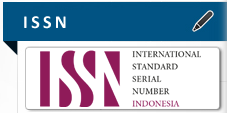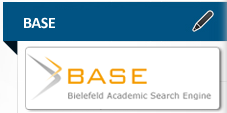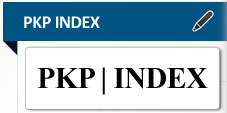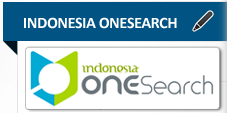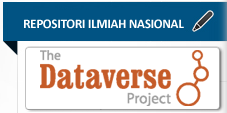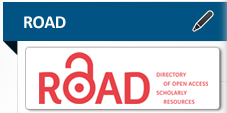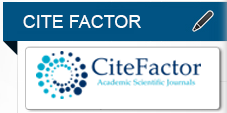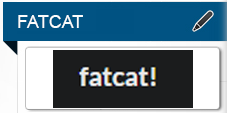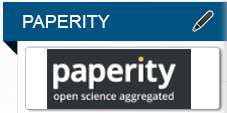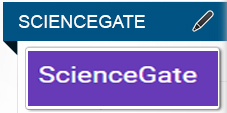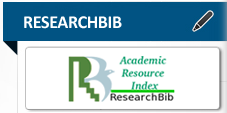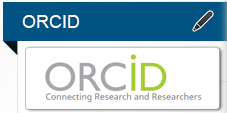ANALISIS BIBLIOMETRIK PUBLIKASI PERKEMBANGAN PENELITIAN PEMASARAN DIGITAL KOSMETIK HALAL
Abstract
ABSTRACT
Digital marketing development becomes the achievement focus of one government program. The government declares the target as a digital economy country in Asia region. Industry advancement correlates to the research activity conducted by academics. There are two types of cosmetics distributed to the market, namely halal cosmetics and non-halal cosmetics. The objectives of this research were to find out (1) the growth of the numbers of research article and citation, (2) the development article and citation level’s progress, (3) the correlation among the authors (co-authors), (4) the co-occurrence of halal cosmetics-related research in digital marketing from 2016 to 2021. This study was conducted by employing bibliometric method. The data collection applied Publish or Perish method using the key words of “Halal Cosmetics” and “Digital Marketing”. The analysis was done to 60 relevant articles throughout 2016 to 2021. The collected data were analyzed using VOSviewer software. The analysis result showed that the growth of the numbers of article publication and citation level tended to increase per year. The publication achievement in 2016 showed that there were two articles with 7 citations. The articles number published in 2021 increased by 45% and there were 27 articles. Article development showed that the article entitled “Determinants of purchase intention of halal cosmetic products among Generation Y consumers” had 19 citations achievement. Co-author analysis suggested that there were 3 clusters formed. The limited number of formed co-author showed the gap of research development on halal cosmetics in digital marketing. Co-occurrence analysis indicated that there were 8 clusters with halal cosmetics’ purchase decision as the most dominant topic.
ABSTRAK
Pengembangan pemasaran digital menjadi fokus capaian salah satu program pemerintah. Pemerintah mencanangkan target sebagai negara ekonomi digital diwilayah Asia. Kemajuan industri berkaitan dengan kegiatan penelitan yang dilakukan oleh akademisi. Terdapat dua jenis kosmetik yang berada di pasar, yakni kosmetik halal serta kosmetik non halal. Penelitian ini bertujuan untuk mengetahui mengetahui (1) pertumbuhan jumlah artikel dan sitasi, (2) Perkembangan Artikel serta tingkat sitasi, (3) Hubungan antar peneliti (co-author), (4) Hubungan antar kata (co–occurrence) penelitian kosmetik halal dalam pemasaran digital pada tahun 2016 – 2021. Penelitian dilakukan dengan menggunakan metode bibliometrik. Pengumpulan data menggunakan Publish or Perish dengan kata kunci “Halal Cosmetics” dan “Digital Marketing”. Data yang terkumpul dianalisa menggunakan perangkat lunak VOSviewer. Hasil analisis menunjukkan bahwa pertumbuhan jumlah publikasi artikel dan tingkat sitasi cenderung meningkat setiap tahun. Capaian publikasi pada tahun 2016 menunjukkan 2 artikel dengan sitasi sebanyak 7. Jumlah artikel yang dipublikasikan pada tahun 2021 mengalami peningkatan mencapai 45% dengan jumlah 27 artikel. Perkembangan artikel menunjukkan artikel dengan judul “Determinants of purchase intention of halal cosmetic products among Generation Y consumers” dengan capaian sitasi sebanyak 19. Analisis co-author menunjukkan klaster yang terbentuk sebanyak 3 klaster. Terbatasnya jumlah yang terbentuk pada co-author menunjukkan celah pengembangan penelitian kosmetik halal dalam pemasaran digital. Analisis co-occurrence menghasilkan 8 klaster dengan topik yang paling dominan adalah keputusan pembelian kosmetik halal.
Keywords
Full Text:
PDF (Bahasa Indonesia)References
Al-Afifi, A. A. M., Yasmin, A., Tasneem, S., & Fatema, K. (2015). international-journal-of-management-science-and-business-administration International Journal of Management Scie... Kathakali phouzder International Journal of Management Science and Business Administration Effectiveness of Digital Marketing in the Challe. International Journal of Management Science and Business Administration, 1(5), 69–80. http://researchleap.com/category/international-journal-of-management-science-and-business-administration
Al-Ansi, A., Olya, H. G. T., & Han, H. (2019). Effect of general risk on trust, satisfaction, and recommendation intention for halal food. International Journal of Hospitality Management, 83, 210–219. https://doi.org/10.1016/j.ijhm.2018.10.017
Amalia, F. (2020). The role of religiosity on halal product purchasing decision case study: Wardah Cosmetics. Journal of Digital Marketing and Halal Industry, 1(1), 19. https://doi.org/10.21580/jdmhi.2019.1.1.4774
Anggadwita, G., Alamanda, D. T., & Ramadani, V. (2020). Halal label vs product quality in halal cosmetic purchasing decisions. Ikonomika, 4(2), 227–242. https://doi.org/10.24042/febi.v4i2.5897
Annabi, C. A., & Ibidapo-Obe, O. O. (2017). Halal certification organizations in the United Kingdom: An exploration of halal cosmetic certification. Journal of Islamic Marketing, 8(1), 107–126. https://doi.org/10.1108/JIMA-06-2015-0045
Ashraf, H. M., Al-Sobhi, S. A., & El-Naas, M. H. (2022). Mapping the desalination journal: A systematic bibliometric study over 54 years. Desalination, 526(August 2021), 115535. https://doi.org/10.1016/j.desal.2021.115535
Bilal, M., Mehmood, S., & Iqbal, H. M. N. (2020). The beast of beauty: Environmental and health concerns of toxic components in cosmetics. Cosmetics, 7(1), 1–18. https://doi.org/10.3390/cosmetics7010013
Briliana, V., & Mursito, N. (2017). Exploring antecedents and consequences of Indonesian Muslim youths’ attitude towards halal cosmetic products: A case study in Jakarta. Asia Pacific Management Review, 22(4), 176–184. https://doi.org/10.1016/j.apmrv.2017.07.012
Dalir, S., GT, O. H., Al-Ansi, A., Rahim, A. A., & Lee, H.-Y. (2020). Increasing profitability of the halal cosmetics industry using configuration modelling based on Indonesian and Malaysian markets*. Journal of Korea Trade, 24(8), 81–100. https://doi.org/10.35611/jkt.2020.24.8.81
Divianjella, M., Muslichah, I., & Ariff, Z. H. A. (2020). Do religiosity and knowledge affect the attitude and intention to use halal cosmetic products? Evidence from Indonesia. Asian Journal of Islamic Management (AJIM), 2(2), 71–81. https://doi.org/10.20885/ajim.vol2.iss2.art1
Donthu, N., Kumar, S., Mukherjee, D., Pandey, N., & Lim, W. M. (2021). How to conduct a bibliometric analysis: An overview and guidelines. Journal of Business Research, 133(March), 285–296. https://doi.org/10.1016/j.jbusres.2021.04.070
El-Gohary, H. (2016). Halal tourism, is it really Halal? Tourism Management Perspectives, 19, 124–130. https://doi.org/https://doi.org/10.1016/j.tmp.2015.12.013
Evelina, L. W., & Safitri, Y. (2019). Customer experience Bali natural beauty care through social media. 2019 International Conference on Information Management and Technology (ICIMTech), 1, 82 86. https://doi.org/10.1109/ICIMTech.2019.8843757
Farida, N., & Firmansyah, A. H. (2020). Analisis bibliometrik berdasarkan pendekatan co-word: Kecenderungan penelitian bidang kearsipan pada Jurnal Khazanah dan Journal of Archive and Record tahun 2016–2019. Khazanah: Jurnal Pengembangan Kearsipan, 13(2), 91-109. https://doi.org/10.22146/khazanah.55690
Fatmi, F. O., Ahmad, A. N., & Kartika, B. (2020). Determinants affecting purchase intention of halal products: an article review. Journal of Halal Product and Research, 3(2), 63. https://doi.org/10.20473/jhpr.vol.3-issue.2.63-79
Fiandari, Y. R., Arifiani, R. S., & Rumijati, A. (2021). Pendampingan strategi branding dan komunikasi pemasaran pada media sosial SMK Muhammadiyah 3 Singosari. 5(02).
Grishikashvili, K., Dibb, S., & Meadows, M. (2014). Investigation into big data impact on digital marketing. Online Journal of Communication and Media Technologies, October, 26–37.
Guan, Z. (2021). Chinese beauty bloggers: amateurs, entrepreneurs, and platform labour. Celebrity Studies, 12(2), 326–332. https://doi.org/10.1080/19392397.2020.1737154
Guleria, D., & Kaur, G. (2021). Bibliometric analysis of ecopreneurship using VOSviewer and RStudio Bibliometrix, 1989–2019. Library Hi Tech, 39(4), 1001–1024. https://doi.org/10.1108/LHT-09-2020-0218
Haidayatullah, D. (2018). Pengaruh label halal pada pertumbuhan kosmetik dan pandangan wanita muslim negara Islam dunia. Kompetensi, 12(1), 1–10. https://doi.org/10.21107/kompetensi.v12i1.4945
Handriana, T., Yulianti, P., Kurniawati, M., Arina, N. A., Aisyah, R. A., Ayu Aryani, M. G., & Wandira, R. K. (2021). Purchase behavior of millennial female generation on cosmetic products. Journal of Islamic Marketing, 12(7), 1295–1315. https://doi.org/10.1108/JIMA-11-2019-0235
Herzallah, D., Leiva, F. M., & Liebana-Cabanillas, F. (2021). To buy or not to buy, that is the question: understanding the determinants of the urge to buy impulsively on Instagram Commerce. Journal of Research in Interactive Marketing. https://doi.org/10.1108/JRIM-05-2021-0145
Hidayat, S. E., Rafiki, A., & Nasution, M. D. T. P. (2021). Halal industry’s response to a current and post-COVID-19 landscape and lessons from the past. Journal of Islamic Marketing, ahead-of-p(ahead-of print). https://doi.org/10.1108/JIMA-06-2020-0180
Islam, M. M. (2021). Evaluating negative attitudes of the students and shoppers towards halal cosmetics products. Journal of Islamic Marketing. https://doi.org/10.1108/JIMA-03-2020-0067
Isnaini, N., Zaida, A. N., & Zulmiati, K. (2021). The influence of halal product image, product design, and marketing strategy on consumer levels in halal cosmetic products (case study on safi). Airlangga International Journal of Islamic Economics and Finance, 4(1), 32. https://doi.org/10.20473/AIJIEF.V4I1.24422
Izberk-Bilgin, E., & Nakata, C. C. (2016). A new look at faith-based marketing: The global halal market. Business Horizons, 59(3), 285–292. https://doi.org/10.1016/j.bushor.2016.01.005
Jia, X., & Chaozhi, Z. (2021). Turning impediment into attraction: A supplier perspective on Halal food in non-Islamic destinations. Journal of Destination Marketing & Management, 19, 100517. https://doi.org/10.1016/j.jdmm.2020.100517
Kannan, P. K., & Li, H. “Alice.” (2017). Digital marketing: A framework, review and research agenda. International Journal of Research in Marketing, 34(1), 22–45. https://doi.org/https://doi.org/10.1016/j.ijresmar.2016.11.006
Katoch, R. (2021). IoT research in supply chain management and logistics: A bibliometric analysis using VOSviewer software. Materials Today: Proceedings. https://doi.org/10.1016/j.matpr.2021.08.272
Khan, N., Sarwar, A., & Tan, B. C. (2021). Determinants of purchase intention of cosmetic products among Generation Y consumers. Journal of Islamic Marketing, 12(8), 1461–1476. https://doi.org/10.1108/JIMA-11-2019-0248
Khatri, M. (2021). Digital marketing and artificial intelligence for evaluating powerful customer experience. International Review of Management and Marketing, 6(6), 658–660.
Kim, J., Kang, S., & Lee, K. H. (2021). Evolution of digital marketing communication: Bibliometric analysis and network visualization from key articles. Journal of Business Research, 130, 552–563. https://doi.org/10.1016/j.jbusres.2019.09.043
KNEKS. (2020). Digitalisasi produk, Wardah jadi pioner kosmetik halal_KNKS. KNEKS. https://knks.go.id/berita/299/digitalisasi-produk-wardah-jadi-pioner-kosmetik-halal?category=1
Kominfo. (2015). Indonesia akan jadi pemain ekonomi digital terbesar di Asia Tenggara. In Berita Kementrian (pp. 1–6).
Kontan. (2020). Mengandung merkuri, ini daftar produk kosmetik berbahaya tahun 2021 menurut Badan POM. https://kesehatan.kontan.co.id/news/mengandung-merkuri-ini-daftar-kosmetik-berbahaya-tahun-2021-menurut-badan-POM
Kusdiana, W., Najib, M. F., & Amalia, F. A. (2021). Pengaruh religiusitas, sikap dan iklan Islami terhadap niat beli produk kosmetik halal lokal. Prosiding Industrial Research Workshop and National Seminar, 12, 978–985. https://jurnal.polban.ac.id/ojs-3.1.2/proceeding/article/view/2840
Leong, Y. R., Tajudeen, F. P., & Yeong, W. C. (2021). Bibliometric and content analysis of the internet of things research: a social science perspective. Online Information Review, 45(6), 1148–1166. https://doi.org/10.1108/OIR-08-2020-0358
Liao, H., Tang, M., Luo, L., Li, C., Chiclana, F., & Zeng, X. J. (2018). A bibliometric analysis and visualization of medical big data research. Sustainability (Switzerland), 10(1), 1–18. https://doi.org/10.3390/su10010166
Mahliza, F., Nugroho, L., & Ali, A. J. A. (2020). Antecedents and consequences of Muslim millennials attitude towards halal personal care products. Ikonomika, 5(2), 249–270. https://doi.org/10.24042/febi.v5i2.7203
Majid, M. B., Sabir, I., & Ashraf, T. (2015). Consumer purchase intention towards halal cosmetics & personal care products in Pakistan. Global of Research in Business & Management, 1(1), 45–53. https://www.researchgate.net/publication/338801113_Consumer_Purchase_Intention_towards_Halal_Cosmetics_Personal_Care_Products_in_Pakistan
Marsudi, M., Fiandari, Y. R., & Fuadiputra, I. R. (2022). Digital marketing in pandemic era (perspective bibliometric). 201–210. https://doi.org/10.1201/9781003263586-25
Marzela, F. (2018). Kolelasi antara kadar merkuri krim pemutih dan kadar merkuri urin pengguna krim pemutih wajah di UNAIR. Jurnal Kesehatan Lingkungan, 10(4), 424–433. https://doi.org/10.20473/jkl.v10i4.2018.424-433
Misra, G., Kumar, V., Agarwal, A., & Agarwal, K. (2016). Internet of Things (IoT) – A technological analysis and survey on vision, concepts, challenges, innovation directions, technologies, and applications (An upcoming or future generation computer communication system technology). American Journal of Electrical and Electronic Engineering, Vol. 4, 2016, Pages 23-32, 4(1), 23–32. https://doi.org/10.12691/ajeee-4-1-4
Mubarok, F. K., & Imam, M. K. (2020). Halal industry in Indonesia; Challenges and opportunities. Journal of Digital Marketing and Halal Industry; Vol 2, No 1 (2020). https://doi.org/10.21580/jdmhi.2020.2.1.5856
Mubarrok, U. S., Ulfi, I., Sukmana, R., & Sukoco, B. M. (2020). A bibliometric analysis of Islamic marketing studies in the “Journal of Islamic Marketing.” Journal of Islamic Marketing. https://doi.org/10.1108/JIMA-05-2020-0158
Ngah, A. H., Gabarre, S., Han, H., Rahi, S., Al-Gasawneh, J. A., & Park, S. H. (2021). Intention to purchase halal cosmetics: Do males and females differ? a multigroup analysis. Cosmetics, 8(1), 1–14. https://doi.org/10.3390/cosmetics8010019
Oklander, M., Oklander, T., Yashkina, O., Pedko, I., & Chaikovska, M. (2018). Analysis of technological innovations in digital marketing. Eastern-European Journal of Enterprise Technologies, 5(3–95), 80–91. https://doi.org/10.15587/1729-4061.2018.143956
Pandey, N., Nayal, P., & Rathore, A. S. (2020). Digital marketing for B2B organizations: structured literature review and future research directions. Journal of Business and Industrial Marketing, 35(7), 1191–1204. https://doi.org/10.1108/JBIM-06-2019-0283
Pasin, O., & Pasin, T. (2021). Bibliometric analysis of COVID-19 and the association with the number of total cases. Disaster Medicine and Public Health Preparedness, 1–6. https://doi.org/DOI:10.1017/dmp.2021.177
Pradana, M., Huertas-García, R., & Marimon, F. (2021). Muslim tourists’ purchase intention of halal food in Spain. Current Issues in Tourism, 24(13), 1814–1818. https://doi.org/10.1080/13683500.2020.1797647
Purwaningwulan, M. M., Suryana, A., Wahyudin, U., & Dida, S. (2019). Creative innovation online relationship marketing Islamic fashion e-commerce in Indonesia. Library Philosophy and Practice, 2019. https://digitalcommons.unl.edu/libphilprac/2579/
Putri, T. U., & Abdinagoro, S. B. (2018). Response to a new wave in digital marketing: Does beauty blogger involvement the most influencing factor in halal cosmetic purchase intention. International Journal of Supply Chain Management, 7(6), 446–452. https://ojs.excelingtech.co.uk/index.php/IJSCM/article/view/2401
Rahem, A. (2018). Identifikasi kandungan alkohol dalam obat di apotik.... of Halal Product and Research, 01(02), 44–49. https://pdfs.semanticscholar.org/ee38/75c6775274732abbac61f0c8ee84ea11a52c.pdf
Rakhmani, I. (2019). The Personal is Political: Gendered Morality in Indonesia’s Halal Consumerism. TRaNS: Trans Regional and National Studies of Southeast Asia, 7(2), 291–312. https://doi.org/DOI:10.1017/trn.2019.2
Ramadhani, F. (2021). Lokal mendominasi! Ini Data Penjualan Kosmetik Bibir di Shopee Bulan Juni 2021. In Compas.Co.Id. https://compas.co.id/article/penjualan-kosmetik-bibir/
Reagan, R., Filice, S., Santarossa, S., & Woodruff, S. J. (2020). #ad on Instagram: Investigating the promotion of food and beverage products. The Journal of Social Media in Society, 9(2), 1–28.
Retno, H., Auliya, S., & Abdassah, M. (2018). Tinjauan bahan berbahaya dalam krim pencerah kulit. Farmaka, 16(2), 214–224. https://doi.org/10.24198/jf.v16i2.16932
Ritz, W., Wolf, M., & McQuitty, S. (2019). Digital marketing adoption and success for small businesses: The application of the do-it-yourself and technology acceptance models. Journal of Research in Interactive Marketing, 13(2), 179–203. https://doi.org/10.1108/JRIM-04-2018-0062
Rosario, A.M.F.T. & Cruz, R. N. (2019). Determinants of innovation in digital marketing. Journal of Reviews on Global Economics, 8(June), 1722–1731. https://doi.org/10.6000/1929-7092.2019.08.154
Sama, R., & Trivedi, J. P. (2019). Factors affecting consumers’ loyalty towards halal cosmetics: an emerging market perspective. International Journal of Business and Emerging Markets, 11(3), 254–273. https://doi.org/10.1504/IJBEM.2019.102655
Samoggia, A., Bertazzoli, A., & Ruggeri, A. (2019). Food retailing marketing management: social media communication for healthy food. International Journal of Retail & Distribution Management, 47(9), 928–956. https://doi.org/10.1108/IJRDM-08-2018-0178
Smith, K. T. (2012). Digital marketing strategies that millennials find appealing, motivating, or just annoying. SSRN Electronic Journal, OCTOBER 2011. https://doi.org/10.2139/ssrn.1692443
Strandberg, C., Nath, A., Hemmatdar, H., & Jahwash, M. (2016). Tourism research in the new millennium: A bibliometric review of literature in Tourism and Hospitality Research. Tourism and Hospitality Research, 18(3), 269–285. https://doi.org/10.1177/1467358416642010
Sugibayashi, K., Yusuf, E., Todo, H., Dahlizar, S., Sakdiset, P., Arce, F. J., & See, G. L. (2019). Halal cosmetics: A review on ingredients, production, and testing methods. Cosmetics, 6(3), 1–17. https://doi.org/10.3390/cosmetics6030037
Suhartanto, D., Dean, D., Sarah, I. S., Hapsari, R., Amalia, F. A., & Suhaeni, T. (2021). Does religiosity matter for customer loyalty? Evidence from halal cosmetics. Journal of Islamic Marketing, 12(8), 1521–1534. https://doi.org/10.1108/JIMA-03-2020-0069
Suparno, C. (2020). Online purchase intention of cosmetics: S-O-R framework application. Journal of Islamic Marketing, ahead-of-p(ahead-of-print). https://doi.org/10.1108/JIMA-09-2019-0192
Taiminen, H. M., & Karjaluoto, H. (2015). The usage of digital marketing channels in SMEs. Journal of Small Business and Enterprise Development, 22(4), 633–651. https://doi.org/10.1108/JSBED-05-2013-0073
Tambo, E., H, A., & A, Y. (2016). Health and beauty cosmeceuticals industry and market expansion in Saudi Arabia. Pharmaceutical Regulatory Affairs, 5. https://doi.org/10.4172/2167-7689.1000172
Tuhin, M. K. W., Miraz, M. H., Habib, M. M., & Alam, M. M. (2022). Strengthening consumers’ halal buying behaviour: role of attitude, religiosity and personal norm. Journal of Islamic Marketing, 13(3), 671–687. https://doi.org/10.1108/JIMA-07-2020-0220
Tupan, T., Rahayu, R. N., Rachmawati, R., & Rahayu, E. S. R. (2018). Analisis bibliometrik perkembangan penelitian bidang ilmu instrumentasi. BACA: Jurnal Dokumentasi dan Informasi, 39(2), 135. https://doi.org/10.14203/j.baca.v39i2.413
Wajdi, M. F., Aji, H. M., & Muhammad, S. (2020). Factors affecting the intention to purchase halal cosmetics on Instagram: E-WOM and brand image. Asian Journal of Islamic Management (AJIM), 2(1), 1–11. https://doi.org/10.20885/ajim.vol2.iss1.art1
Widyanto, H. A., & Agusti, C. R. (2020). Beauty influencer in the digital age: How does it influence purchase intention of generation Z? Jurnal Manajemen Dan Pemasaran Jasa, 13(1), 1–16. https://doi.org/10.25105/jmpj.v13i1.5453
Widyanto, H. A., & Sitohang, I. A. T. (2021). Muslim millennial’s purchase intention of halal-certified cosmetics and pharmaceutical products: the mediating effect of attitude. Journal of Islamic Marketing, 13(6), 1373–1394. https://doi.org/10.1108/JIMA-04-2020-0117
Xie, L., Chen, Z., Wang, H., Zheng, C., & Jiang, J. (2020). Bibliometric and visualized analysis of scientific publications on atlantoaxial spine surgery based on Web of Science and VOSviewer. World Neurosurgery, 137, 435-442.e4. https://doi.org/10.1016/j.wneu.2020.01.171
Yasin, R. M., & Norjanah, S. (2021). The influenced factors of the switching customer to halal cosmetic products. Indonesian Journal of Halal Research, 3(1), 27–33. https://doi.org/10.15575/IJHAR.V3I1.10536
Yusuf, E., & Yajid, M. S. A. (2017). Related topic: Halal cosmetics bt (K. Sugibayashi (ed.); pp. 101–107). Springer Japan. https://doi.org/10.1007/978-4-431-56526-0_8
Zhu, G. (2019). Precision retail marketing strategy based on digital marketing model. Science Journal of Business and Management, 7(1), 33. https://doi.org/10.11648/j.sjbm.20190701.15
DOI: https://doi.org/10.14203/j.baca.v43i2.843
Copyright (c) 2022 BACA: JURNAL DOKUMENTASI DAN INFORMASI

This work is licensed under a Creative Commons Attribution-NonCommercial-NoDerivatives 4.0 International License.



